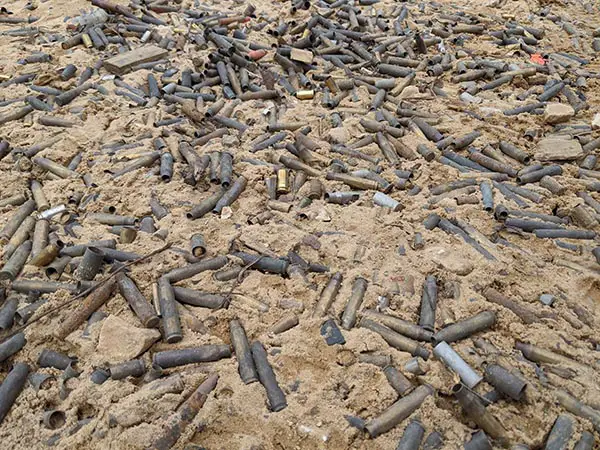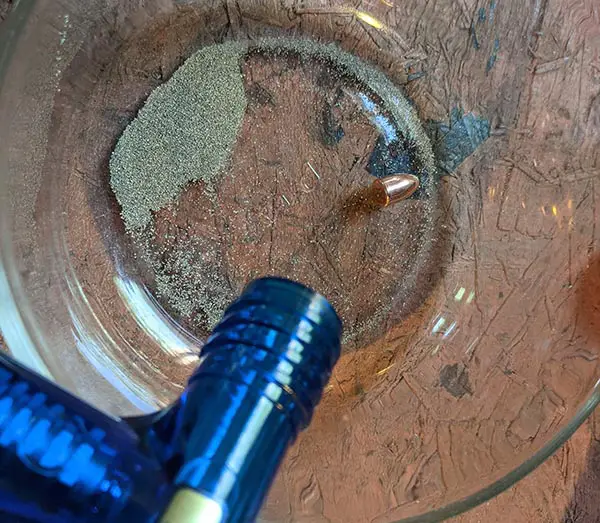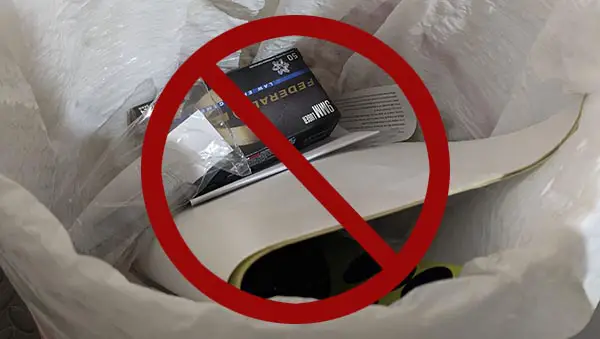Ever inherited an old batch of ammunition from a friend? Perhaps you’ve got unusable ammo laying around that you want to dispose of or recycle. Below are 6 options to dispose of unwanted or unserviceable ammo. Help protect the environment by getting rid of your ammo the proper way.
Table of Contents
1. Return Ammunition To The Seller
If you’ve got a bad set of ammunition, you should reach out to the seller directly. Although many stores indicate “all sales are final” no federal law prohibits ammunition return. However, there are restrictions on the mailing of hazardous materials. Therefore, an in-person return is your best option.
Additionally, problems with factory ammunition may indicate a larger problem with the entire batch produced. Attempting to return a recent ammo purchase to the seller helps alert manufacturers to potential problems.
According to takethegun.com the window for returning ammo to the seller varies between 0 and 60 days. However, if you encounter resistance at your local ammo supplier, you have other options for getting rid of defective ammo.
2. Dispose Of Ammo With Law Enforcement
Contacting your local law enforcement office or fire department is another way to dispose of unwanted ammunition. According to SAAMI, these sources can provide you the means to dispose of ammunition in compliance with local, state, and federal law.
If you opt to dispose of ammunition this way, here are tips for the transfer:
- Contact the station in advance and let them know you plan to turn over ammunition.
- Some departments will come to your home to take possession of the unwanted ammo.
- Separate ammunition from firearms.
- Do not bring firearms or ammunition into the station.
3. Bring Ammo To The Range For Disposal

Another way to get rid of ammunition is by taking it to your local shooting range. Simply provide the ammunition to the front desk or range safety officer for disposal. Don’t dump the live cartridges onto the lanes.
4. Recycle Ammo At A Hazmat Facility
Most dumps and landfills also have a building or section of the facility dedicated to hazardous materials. Therefore, you can dispose of ammunition at these locations. If you plan to dispose of ammunition this way, ensure the facility is open and accepts ammunition.
Oftentimes the hazmat offices are only open on select days. Additionally, these facilities process different types of hazardous materials. Therefore, inquire with staff about where you should drop off your ammunition.
5. Decommission Cartridges Yourself

By far, my favorite way to dispose of ammo is by decommissioning cartridges myself. Using a bullet puller I separate out the components. Usually, I can re-use the case even if the powder or other parts of the cartridge are compromised.
However, if you are unfamiliar or uncomfortable around ammunition, I do not recommend this method. Additionally, some cartridges are beyond salvation and you should be able to identify the difference.
But, if this sounds interesting to you, I highly recommend you check out my article on reloading because you’re a prime candidate for making your own ammunition.
6. Give Ammo To A Friend
When all else fails, you can dispose of ammunition by unloading it on a friend. Whether they choose to shoot the ammunition, decommission it themselves, or trash it becomes their responsibility.
However, I recommend you only give ammo to someone knowledgeable about ammunition and firearms. Additionally, make sure they are legally allowed to possess ammunition.
When To Dispose Of Ammunition
If you’re on the edge and don’t know whether you should dispose of your ammo, here are some hints that it’s time. Usually defects or structural compromises of a cartridge render it unserviceable. Additionally, ammunition left in an environment that impacts performance of the primer or powder charge should be disposed of.
- Ammo has excessive visible corrosion or structural damage to the case (e.g. bad dent or puncture).
- Cartridges have been exposed to oils, lubricants, or solvents that could compromise the ammo.
- Ammunition fails to chamber reliably (e.g. bullet is seated too deep in the case).
- Cartridges have been in a flood, or immersed in water.
- Ammunition that has been in a fire.
However, storing your ammunition properly will extend the life of your cartridges and prevent scenarios that require your ammunition disposal.
How NOT To Dispose Of Ammunition
Above are acceptable options for recycling or disposing of ammo. However, I think it would also be prudent to discuss the wrong way to decommission cartridges. Therefore, here are the top 3 ways people dispose of ammo that are not safe.
Do NOT Dispose Of Ammo In The Trash

Throwing ammunition in the trash is dangerous and illegal. But why? First, a cartridge does not cease working because you decide you no longer want it.
The right amount of force applied in the correct location can cause a round to discharge. Other trash can act as a firing pin in the event a trash compactor or other device is used. This puts sanitary service personnel at risk.
Additionally, trash can end up in a landfill and hazmat is bed for the environment. Next, lets discuss why putting unused ammo in the ground is a bad idea.
Do NOT Bury Ammunition
Burying ammo can lead to problems in the water and soil. Bullets are made of lead which can seep into the soil.
If your household relies on well water, you may inadvertently contaminate your drinking water. Alternatively, burying ammo could impact the local wildlife by poisoning drinking water or seeping into the soil and absorbed by local plant life.
Suffice it to say, you should NOT dispose of ammunition by burying it.
Do NOT Dispose Of Ammo In A Fire
Although fire will not propel the bullet at dangerous velocities, small components including the primer and shards of the case may be expelled. Usually, only those in close proximity to the cartridge when it detonates are at risk of injury.
However, whether a round will detonate after a few seconds or a couple minutes depends on a number of factors. Therefore, I recommend you do not put live cartridges into an open fire.
Parting Shots
Ultimately, disposing or recycling ammunition isn’t a big deal. There are multiple ways to dispose of your cartridges responsibly that protect the environment and prevent problems with law enforcement. If you’ve found this content helpful, please share with your social networks or leave a comment. Thanks for stopping in.










